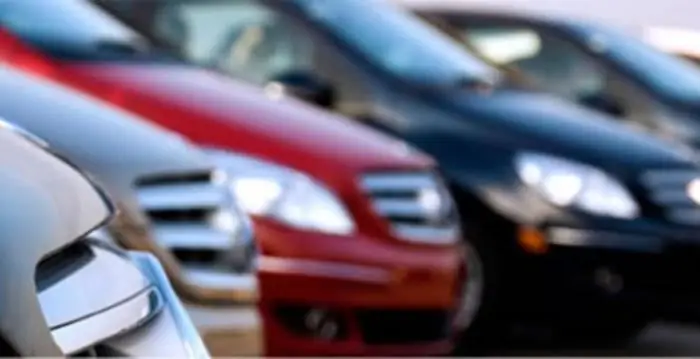2025 Author: Erin Ralphs | [email protected]. Last modified: 2025-01-22 21:14:12
The Mercedes Benz Sprinter belongs to a family of commercial vehicles that have been produced since 1995 in Germany. The line includes low-tonnage vehicles, including refrigerated trucks, all-metal vans, flatbed trucks. There are even specialized modifications, such as, for example, an ambulance, a mobile headquarters. Due to the fuel consumption of the Mercedes per 100 km, it is often used as a fixed-route taxi or a passenger bus. On sale are available options with automatic or manual transmission, with all-wheel or part-wheel drive. Since 2012, these cars have been produced in Russia in modifications W901-W905.

What affects the fuel consumption of a Mercedes Sprinter per 100 km?
The fuel consumption of this car is not standard and depends on a number of parameters. It should be borne in mind that there are different modifications of this model with gasoline and diesel engines. Given the different technology of engine operation and efficiencyfuel consumption will vary greatly between engines requiring different types of fuel. The type of gearbox, drive, vehicle load and even the driving style of the driver also play a role, not to mention the strength of the motor itself.

What is the fuel consumption of a Mercedes Benz per 100 km?
Having climbed on specialized car forums, you can find reviews of the owners of these cars with an indication of consumption. So, a model with a diesel engine with a capacity of 79 horsepower produced in 1997 consumes 10 liters per 100 kilometers. We are talking about a motor with a cylinder capacity of 2.3 liters. The same car with a stronger engine of 122 horsepower (2.9 liters) "eats" 10-12 liters of diesel fuel per 100 kilometers.
There are also owners who indicate a higher consumption - up to 13-15 liters per hundred, although the average fuel consumption of a Mercedes per 100 km is around 10-12 liters. And that's in mixed city/highway mode. More specifically, in the city the car consumes 12 liters of fuel, on the highway - 9-10. If you shift gears perfectly, moderately load the engine itself and minimize stops, then in urban conditions you can achieve savings of up to 10 liters per hundred.

Remarkably, newer cars made in 2006 and younger consume the same amount of fuel. That is, a 122-horsepower 2.9-liter engine "eats" 9-10 liters per hundred for some drivers and 10-11 liters for others.
What is the fuel consumption per 100 km for a car of this brand with a gasoline engine?
Let's start with the fact that basically only diesel versions of this car are sold on the market. Gasoline "Sprinter" is something like exotic. However, if you search on used car sales sites, you can find such options.
Judging by the reviews, fuel consumption per 100 km for a Mercedes Sprinter with a gasoline engine is 15-16 liters. Given the lower efficiency of this type of fuel, this consumption is fully justified. Moreover, there are some advantages from using gasoline: the engine starts easily even at a temperature of -25 degrees. The engine itself is quieter, traction is excellent.
Some owners of these cars install 150 liter propane gas tanks. Gas consumption on this car is 17-19 liters per 100 kilometers.
Conclusion
Here is a universal car "Mercedes Sprinter". He knows how to drive on all types of fuel: gasoline, diesel, gas. True, diesel versions are mainly produced and sold on the market, although if you wish, you can even find gasoline "Sprinters" and, if necessary, install gas equipment.
Can a car be called economical? Quite, because with an engine capacity of 2.9 liters, the fuel consumption per 100 km for a Mercedes of 9-10 liters is an excellent indicator. Some cars "guzzle" about the same amount of fuel, but the "Sprinter" is a van, and it is shown to consume muchmore fuel than a regular car.
Recommended:
Real fuel consumption of "Lada-Grants" per 100 km

Automatic gearboxes (automatic transmissions) have been mass-produced since the middle of the last century. A lot has changed in the intervening time. The cars have become different, and the transmission has become much more perfect. World auto giants all this time did not cease to amaze with new products. Only in Russia the word "automatic" was steadily associated with the name of the great weapons designer. And so it happened. In 2012, the first domestic car of this type, the Lada Granta, rolled off the assembly line
UAZ "Hunter": fuel consumption per 100 km and specifications

UAZ "Hunter" SUV: description, history of creation, fuel consumption, features. Domestic SUV UAZ "Hunter": specifications, photos, interesting facts. How to reduce fuel consumption on UAZ "Hunter"?
"Nissan Qashqai" - fuel consumption per 100 km: norms for automatic and manual. Nissan Qashqai

"Nissan Qashqai": fuel consumption per 100 km, specifications, modifications, photos, owner reviews. "Nissan Qashqai 2019": device, design features, engine, recommendations for saving fuel. Nissan Qashqai: description, automatic and mechanics
Why increased fuel consumption? Causes of increased fuel consumption

A car is a complex system where each element plays a huge role. Almost always, drivers face various problems. For some, the car drives to the side, others experience problems with the battery or exhaust system. It also happens that fuel consumption has increased, and suddenly. This puts almost every driver in a stupor, especially a beginner. Let's talk in more detail about why this happens and how to deal with such a problem
Fuel: consumption rate. Consumption rates of fuels and lubricants for a car

In a company where vehicles are involved, it is always necessary to take into account the cost of their operation. In the article, we will consider what expenses should be provided for fuels and lubricants (POL)

